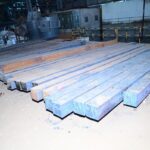If you’ve paid any attention to the news over the past five years, you’ve noticed markets across several industries falling victim to volatility brought on by insulant production and accumulated demand. several influences have caused this, most notably the COVID-19 pandemic, the war in state, and therefore the potential recessions several countries are presently facing.
Steel is not any trespasser to unsteady market conditions, and lots of concern the chance of a volatile steel market wherever demand and worth plummet, going away suppliers with giant quantities of steel and no-one to get. Let’s look into what market volatility is, what it means that to the industry, what a number of the causes is also, and the way it affects demand and worth.
WHAT IS MARKET VOLATILITY?
In general terms, market volatility refers to the up or down amendment within the worth or price of products and services throughout a particular amount of your time. Volatility is measured by what quantity a market changes compared to the average for that business. Changes that cause volatility are typically sudden and unpredictable, brought on by a lot of important events like pandemics, wars, recessions, inflation, and policy — to call a number of.
WHAT DOES MARKET VOLATILITY LOOK LIKE IN THE STEEL INDUSTRY & HOW IS IT?
With relevance the industry, market volatility mirrors that of the other business. once changes in steel worth occur thanks to important government events, demand rises or falls as a response. Generally, once demand falls, costs additionally fall, and the other way around. This sometimes leaves mills and suppliers with either a surplus or a shortage of metal reachable.
WHAT CAUSES IT?
As mentioned, larger geo-political events tend to affect the price volatility of steel. Despite the fact that an event itself may not have an immediate impact, it’s the consequences of the event that have an impact on demand and how a product is used. When it comes to steel, a larger event such as a war could increase demand for military uses, which in turn would drive up the price. Furthermore, a sudden infrastructure bust could limit construction, resulting in lower demand and prices.
HOW IT'S CURRENTLY AFFECTING STEEL PRICES
Inflation, supply chain bottlenecks caused by COVID, and the Ukrainian war are contributing to falling metal prices across the country. Though many in the industry are optimistic about the U.S. avoiding a recession, many are skeptical about purchasing large quantities of steel and other metals.
WHAT THAT MEANS FOR ORDER QUANTITIES
When purchasing demand drops, steel mills and suppliers become concerned, which slows production. Cutting back on large quantity orders would be a safer bet for both suppliers and those buying steel, rather than risking being stuck with an excess of product. In reality, minimum order quantities are few and far between in the metals industry.
HOW KESRI ALLOYS CAN HELP ?
Steel prices may remain uncertain, but one thing is certain – Kesri Alloys offers low-volume metal products, high-volume metal products, and everything in between. By meeting our customers’ specific requirements, we eliminate the need to deal with excess products. We are able to handle a wide range of projects, including cold rolled A109 strip steel, annealed spring steel, stainless steel, and tempered spring steel.
Contact Kesri Alloys for a quick quote on high or low-volume orders of specialty metals. Whenever you have questions or need assistance, our expert staff will be happy to help.




